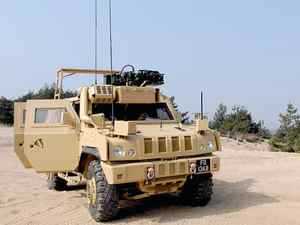
The latest armoured vehicles being sent to do battle with the Taliban are tested to the limit by a specialist unit at Bovington in Dorset.
Bovington Camp, established in 1916, is the home of the Royal Armoured Corps and an ideal location to trial and test the latest armoured equipment in use on operations worldwide.
Surrounded by 10,000 acres of undulating Dorset countryside, it is here that the Army's Armoured Trials and Development Unit (ATDU) gets its hands on the latest vehicles for the armoured soldier, and some of the specialist vehicles like Panther.
Following a series of trials Panther is being delivered to the front line for use in the force protection role by the Royal Engineers, Royal Logistic Corps and RAF Regiment. Changes to bring it up to 'theatre entry standard' include adding a rear view camera for improved situational awareness, and protection for the engine compartment.
The ATDU's Commanding Officer, Lieutenant Colonel Chris Borneman, said:
"Our number one priority is support to current operations. The unit is very much part of a wider team involving DE&S [Defence Equipment & Support], industry and the Army, and is aiming to produce the best for soldiers on the front line.

Lance Corporal Charlie Manchester of the ATDU added:
"At the end of the day it's me and my friends that use the kit, so we need to make sure it's the best it can be."
Lance Corporal of Horse Martin Privett, also now working at the ATDU, has recently returned from Afghanistan. He said:
"When I was there we were stopping twice a day to clear out the engine air filters on our Scimitar reconnaissance vehicles. A new system was developed here and that changed it to once a week. Now we've developed a new filter system, and they've done between eight and ten thousand miles without needing to change the filter once."
Trials are not just done on vehicles though, they can include the clothing, food and fuel used by the crews:
"What is right for the infantry is not necessarily right for armoured troops," said Lieutenant Colonel Borneman.
"For example, the new infantry helmet is great, but not suitable for wearing in a Scimitar because it won't fit easily with the sighting systems in the turret. We work closely with DE&S project teams to get the kit right for operations."

"We look at the armoured soldier as a system," said Major Ian Simpson.
"Everything to do with the soldier is dealt with here; clothing, eye-wear, helmets, boots. Boots for example can be great out in the field, but are they suitable for wearing inside a tank with its cramped working environment? Are they going to be comfortable when you're sitting down for a long time? Will they slip on the pedals? These are all areas that must be looked at.
"We've done a lot of development work on body armour, integrating it with particular platforms. It may do an excellent job, but can you get in and out of the turret while wearing it? Can we reduce the bulk without degrading the protection?
"We've also trialled a body armour system that can be integrated with the cooling system in the vehicle."
Trial lengths vary depending on what is being trialled, but they can range from five days to six months depending on the question being asked. Often trials replicate what the vehicle actually does on operations; if a Panther is driven on patrol for 14-hours-a-day, seven-days-a-week, then ATDU do so too.
Although ATDU can replicate a lot of what is being done on operations, when performing driving trials they can't replicate the heat:
"We can send a vehicle away for 'cooking' in a specialist unit, but that can only be for static trials," said Lieutenant Colonel Borneman. "So we can replicate the increased engine workload caused by the heat by adding weight to the vehicles."
A major part of the work at ATDU involves Urgent Operational Requirements (UORs):
"UORs are a very exciting part of our work," said Lieutenant Colonel Borneman, "because they are the 'here and now'. Both military and civilian staff love it because they can see the results and benefits of their hard work."
Military equipment has evolved over time:
"Twenty years ago we didn't know we'd be in Afghanistan, and much of our equipment was designed for a European battlefield," said Lieutenant Colonel Borneman.
"Requirements will change, and along with DE&S, industry and feedback from the front line, we will strive to improve what we have in service to deal with those changes."
- ATDU, in its present form, dates back to the mid-1950s, but can trace its lineage to the Great War.
- There are seven trials and development units within the Army. ATDU is one of the largest and staffed by a mixture of around 60 soldiers and civilians. Soldiers come to the unit for between two and three years, and must have had recent front line experience, bringing all the latest tactical awareness and experience.
- Commanding Officer Lieutenent Colonel Chris Borneman goes to Afghanistan every six months to see for himself how equipment is currently being used on operations.
- Coming into service soon is the Warthog, which will be undergoing trials with the ATDU.
- The team is also looking ahead to the Future Rapid Effects System (FRES). When it is introduced it will also undergo trials at Bovington.
U.K. MoD
01.09.2009